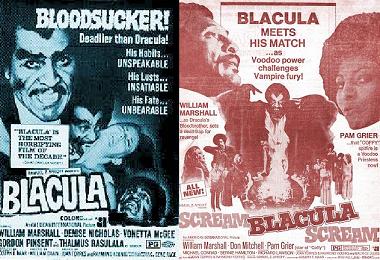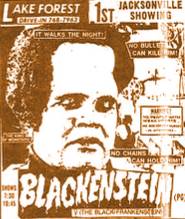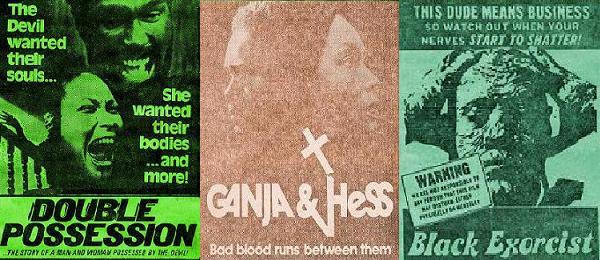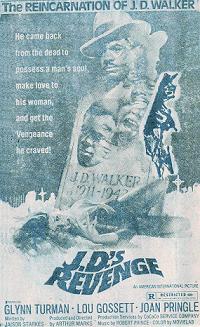The Lost Drive-In: Sinister Soul Cinema
Sinister Soul Cinema, try saying that one three time fast! Blaxploitation was a dumping ground genre for a lot of films in the 1970’s that weren’t even necessarily connected by the anticipated bond of a predominantly African-American cast. Since almost any type of film could be reworked (usually by white producers) to presumably appeal to a black audience, many interesting sub-categories emerged within this genre. My favorite among these are the horror films that ranged from reasonably straight fright flicks with a color variation to ludicrous mishmashes that did not work well on any level. This installment of The Lost Drive-In takes a look back at some of these Blaxsploitation horror films and the lurid advertisements that announced them.
 Blacula (1972) was the granddaddy of all Blaxsploitation horror films and also one of the best due largely in part to the excellent casting of William Marshall as the vampire and Thalmus Rasulala as his Van Helsing-like adversary. In an excellent pre-credits sequence, African Prince Manuwalde (Marshall) and his Princess visit Count Dracula (who apparently has a summer castle in Africa!) to appeal to him for help in ending the slave trade. Unfortunately the Count gets jungle fever for Mrs. Manuwalde and things end badly with the Prince cursed with vampirism (and the name Blacula) and imprisoned in a coffin. Many years later the contents of the castle are transported to modern day (1970s) Los Angeles and you can imagine the rest. While the second half of the film doesn’t live up to the strong beginning, there is a well thought out subplot with Blacula being appalled by modern society and preying on its more corrupt elements. Needless to say, Blacula cleaned up at the box office and a sequel, Scream, Blacula, Scream (1973), was rushed into production. This one mixes in another popular Blaxsploitation subject, voodoo, but suffers from the absence of Rasulala. We do, however, get Pam Grier as a high priestess and a sub-plot about a voodoo ritual supposedly being able to free Blacula from his curse to liven things up.
Blacula (1972) was the granddaddy of all Blaxsploitation horror films and also one of the best due largely in part to the excellent casting of William Marshall as the vampire and Thalmus Rasulala as his Van Helsing-like adversary. In an excellent pre-credits sequence, African Prince Manuwalde (Marshall) and his Princess visit Count Dracula (who apparently has a summer castle in Africa!) to appeal to him for help in ending the slave trade. Unfortunately the Count gets jungle fever for Mrs. Manuwalde and things end badly with the Prince cursed with vampirism (and the name Blacula) and imprisoned in a coffin. Many years later the contents of the castle are transported to modern day (1970s) Los Angeles and you can imagine the rest. While the second half of the film doesn’t live up to the strong beginning, there is a well thought out subplot with Blacula being appalled by modern society and preying on its more corrupt elements. Needless to say, Blacula cleaned up at the box office and a sequel, Scream, Blacula, Scream (1973), was rushed into production. This one mixes in another popular Blaxsploitation subject, voodoo, but suffers from the absence of Rasulala. We do, however, get Pam Grier as a high priestess and a sub-plot about a voodoo ritual supposedly being able to free Blacula from his curse to liven things up.
 Of course the producers of Blacula were not the only ones who noticed its success in the theaters, other film companies did too. Blackenstein (a.k.a. Black Frankenstein) (1973), the most obvious of the imitators is also one of the worst. A lot could have been done with an ethnic updating of the classic Mary Shelley Frankenstein tale but this film went for exploitation value rather than story. Instead of any clever ideas or creativity, we get social commentary on the Vietnam War and a sex crazed monster that makes a point of ripping women’s shirts open before he kills them. The result is a mess that plods slower than the monster and even the special effects of the original Frankenstein film’s Kenneth Strickfaden can’t save this jive turkey!
Of course the producers of Blacula were not the only ones who noticed its success in the theaters, other film companies did too. Blackenstein (a.k.a. Black Frankenstein) (1973), the most obvious of the imitators is also one of the worst. A lot could have been done with an ethnic updating of the classic Mary Shelley Frankenstein tale but this film went for exploitation value rather than story. Instead of any clever ideas or creativity, we get social commentary on the Vietnam War and a sex crazed monster that makes a point of ripping women’s shirts open before he kills them. The result is a mess that plods slower than the monster and even the special effects of the original Frankenstein film’s Kenneth Strickfaden can’t save this jive turkey!
 The director of Blacula, William Crain, tried to capture the same success three years later with Dr. Black and Mr. Hyde (a.k.a. The Watts Monster) (1975). Why this wasn’t called Dr. Black and Mr. White is anyone’s guess since the doctor is actually named Pryde (played by Bernie Casey) and his monstrous alter ego is never referred to as Hyde but is ashen in color. Casey works in a free clinic when he isn’t busy with his side experiments for regenerating damaged tissue. After making the mistake of testing his new serum on himself (when will these guys ever learn?), Dr. Pryde transforms into a hulking beast man with a penchant for killing prostitutes and their pimps. Like Blacula, Dr. Black and Mr. Hyde actually does try to work in a back story and some motivations but it isn’t nearly as successful. This one came out towards the end of the genre’s popularity and did not do well financially so we never got the Black Mummy or Creature from the White Lagoon!
The director of Blacula, William Crain, tried to capture the same success three years later with Dr. Black and Mr. Hyde (a.k.a. The Watts Monster) (1975). Why this wasn’t called Dr. Black and Mr. White is anyone’s guess since the doctor is actually named Pryde (played by Bernie Casey) and his monstrous alter ego is never referred to as Hyde but is ashen in color. Casey works in a free clinic when he isn’t busy with his side experiments for regenerating damaged tissue. After making the mistake of testing his new serum on himself (when will these guys ever learn?), Dr. Pryde transforms into a hulking beast man with a penchant for killing prostitutes and their pimps. Like Blacula, Dr. Black and Mr. Hyde actually does try to work in a back story and some motivations but it isn’t nearly as successful. This one came out towards the end of the genre’s popularity and did not do well financially so we never got the Black Mummy or Creature from the White Lagoon!

Can anyone guess what Double Possession, Ganja and Hess, and Black Exorcist have in common? If you said they were all the same film you are almost right. Ganja and Hess (1973) started life as an intelligent movie about an archeologist (Night of the Living Dead’s Duane Jones) who becomes a vampire after being stabbed with an ancient dagger. He falls in love with the widow of his assistant who eventually becomes a vampire herself. Like Scream, Blacula, Scream, it also carries some heavy voodoo undertones. The film proved too slow and serious for the exploitation crowd when it was initially released so it was dramatically re-edited and re-scored and re-released multiple times with all sorts of weird advertising campaigns to try to fool potential audiences. Since The Exorcist was breaking box office records at the time, the possession angle was heavily emphasized for some ads even though the film had nothing to do with demons. It would take many years for Ganja and Hess to be restored and released on home video where it found a more accepting audience.
 Speaking of The Exorcist and possession films, J.D.’s Revenge (1976) has plenty of those elements in at as well as its own funky style. This movie even manages to cash in on The Reincarnation of Peter Proud (1975) which was another hot topic of the day. A young law student named Isaac who becomes possessed by the spirit of a 1940’s gangster during a hypnosis act. The specter of J.D. Walker is restless and has been wandering in limbo ever since he was blamed for a murder he did not commit and then murdered himself by the real killer to cover his tracks. Revenge is filled with some great conflicting personality sequences and a better plot than usual with the mild mannered Isaac slowly transforming into the bad ass J.D. The cast is also better than average and includes Louis Gossett Jr. as the man who incorrectly accuses J.D. of the murder and sets the events in motion.
Speaking of The Exorcist and possession films, J.D.’s Revenge (1976) has plenty of those elements in at as well as its own funky style. This movie even manages to cash in on The Reincarnation of Peter Proud (1975) which was another hot topic of the day. A young law student named Isaac who becomes possessed by the spirit of a 1940’s gangster during a hypnosis act. The specter of J.D. Walker is restless and has been wandering in limbo ever since he was blamed for a murder he did not commit and then murdered himself by the real killer to cover his tracks. Revenge is filled with some great conflicting personality sequences and a better plot than usual with the mild mannered Isaac slowly transforming into the bad ass J.D. The cast is also better than average and includes Louis Gossett Jr. as the man who incorrectly accuses J.D. of the murder and sets the events in motion.
Ladies and gentlemen, the management would like to thank you for joining us this evening. Please remember to replace your speakers on the stands before pulling away in your vehicle and come back and visit us again soon at The Lost Drive-In!
